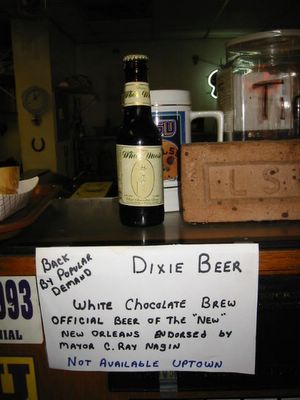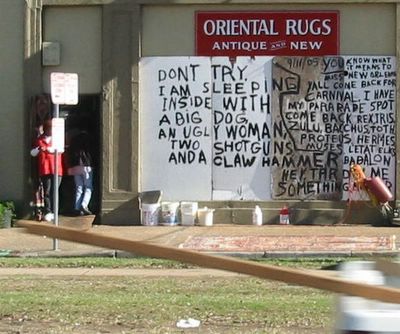Tuesday, February 28, 2006
Tuesday, February 21, 2006
Monday, February 20, 2006
Ask Dr. Cracky
I sent my friend Michael a link to an article about the dangers of ecstasy use. He e-mailed me back:
I replied:
Did [you] see in this article that people don't die from taking ecstasy, but die because they have had "too much water"?! Too much water? Can someone really die while dancing because they had too much water?
I replied:
Well, yes and no. It's not really the water itself that's the problem. It's the problem of maintaining a proper water-sodium balance.
If you're up dancing all night long, you lose a lot of water and sodium through your sweat. If you drink nothing but water, you replace the water lost through sweat but not the sodium. As you continue to dance, your blood sodium levels continue to drop.
The condition of abnormally low blood sodium levels is called hyponatremia. Symptoms of mild to moderate hyponatremia include nausea, muscle cramps, disorentation and confusion. Extreme hyponatremia can cause seizures, a coma or even death. The fact that you and everybody around you is cracked out probably means that you (and your friends) are less likely to identify when you have a problem and need treatment.
Cutting down on the amount of water you drink is not a good solution. Hyponatremia can occur when you are dehydrated as well.
The best solution is probably to (a) cut down on the amount and duration of dancing (and sweating), and (b) drink plenty of sodium-rich fluids (like Gatorade). Dancing all night on a sweaty dancefloor is like any other endurance event. You wouldn't run a marathon or compete in an Ironman without replacing both water and sodium, so why would you dance and sweat all night long without replacing them as well?
Monday, February 13, 2006
The Gentleman Friend
The Gentleman Friend and I decide to go running in Golden Gate Park.
HIM: How far do you want to run?
ME: Not long. Maybe 45 minutes.
HIM: Let's run to the lake. The one with the ducks and the Asians.
ME: Every lake in Golden Gate Park has ducks and Asians.
HIM: How far do you want to run?
ME: Not long. Maybe 45 minutes.
HIM: Let's run to the lake. The one with the ducks and the Asians.
ME: Every lake in Golden Gate Park has ducks and Asians.
Monday, February 06, 2006
Pictures From New Orleans
When I tell people that I was in New Orleans last week, they ask "What's it like?" It's not an easy question to answer. For one thing, I stayed downtown, which is one of the neighborhoods least affected by the flooding. I never got close to the Lower Ninth Ward or any of the truly devastated neighborhoods. But even downtown things were not back to normal.
For example, when I checked into my hotel, I learned that room service, voicemail, the gym, valet parking, ice and the mini-bar were not available. While housekeeping would tidy up every day, the hotel would change the sheets only every three days. Now, it's not as if any of that affected me in any significant way. The only thing I missed was the gym. However, the air conditioning worked, the hotel had plenty of water pressure and WWOZ was back on the air, so I really couldn't complain.
The central things to realize about New Orleans are that everything was damaged in some way and that almost everything is still damaged. If you walk down Poydras Street, which is the main business street in New Orleans, you will notice that even the skyscrapers, the most valuable real estate in the city, are not yet completely fixed. I never learned why. Perhaps it's due to negotiations with FEMA or insurance carriers, or perhaps it's simply due to the difficulty in sourcing replacement windows and roof tiles.
Obviously, the damage to housing stock was much more far reaching. If you look out over the city, you see a field of blue tarps covering the roofs of houses. Look more closely and you see boarded-up buildings and buildings that are partially collapsed. Even in the Garden District I saw trash in front of houses. It's odd, because I saw plenty of garbage trucks picking up trash (at least for sidewalk trashcans).
Another thing that you quickly realize about New Orleans is that if it isn't completely broken, it's not a priority. For example, the city did tow abandoned cars, but only to out-of-the-way parking lots, where they still sit.
Or take the case of traffic lights. I was told that only 10% of the traffic lights in town are working. A certain amount of that makes sense. Traffic levels are down significantly from pre-Katrina levels. Many neighborhoods no longer have a need for traffic lights. The city has restored traffic lights where they are most needed, on Poydras Street and other major streets. However, just because service has been restored does not mean that the traffic lights are "fixed." Many traffic lights are tilted to one side. Street signs are up, but they don't necessarily point in the right direction.
Political tensions don't seem to be fixed either. Mayor Nagin's "Chocolate City" comments did not sit well with the white residents of New Orleans with whom I spoke.
However, Mayor Nagin's comments are not the largest problem facing New Orleans. The largest problem facing New Orleans is a critical lack of housing. Businesses are up and running and Help Wanted ads are everywhere, yet there is nobody to hire. The reason there is nobody to hire is because there is nowhere to live. City workers, what's left of them, are lving in two giant cruise ships docked along the Mississippi. Rows of trailers, the kind you hitch behind a Chevy Suburban on your summer vacation, are parked in lots along Poydras Street. House trailers provided by FEMA are held up over concerns where to place them.
Oh, and there's environmental damage, too. Trees, mostly oaks and cypresses, all over the city are dying. The cause? Saltwater incursions during the flooding. It is still winter down in New Orleans, so many of the leafless trees are simply dormant. As I walked along the city streets, I tried to figure out which trees had died. I turned it into a game called "Dead or Deciduous?"
It seemed somehow grimly fitting that on the night before I was to leave, a severe thunderstorm hit the city. The storm spawned tornadoes, at least one waterspout and damaged several buildings including the airport. I was supposed to leave out of the C Concourse, but that concourse had been closed. A possible tornado hit the concourse, damaged the (temporary) roof and snapped a couple of jetways in two. The bus stop shelter poster posted above? Ripped down by the winds.
For example, when I checked into my hotel, I learned that room service, voicemail, the gym, valet parking, ice and the mini-bar were not available. While housekeeping would tidy up every day, the hotel would change the sheets only every three days. Now, it's not as if any of that affected me in any significant way. The only thing I missed was the gym. However, the air conditioning worked, the hotel had plenty of water pressure and WWOZ was back on the air, so I really couldn't complain.
The central things to realize about New Orleans are that everything was damaged in some way and that almost everything is still damaged. If you walk down Poydras Street, which is the main business street in New Orleans, you will notice that even the skyscrapers, the most valuable real estate in the city, are not yet completely fixed. I never learned why. Perhaps it's due to negotiations with FEMA or insurance carriers, or perhaps it's simply due to the difficulty in sourcing replacement windows and roof tiles.
Obviously, the damage to housing stock was much more far reaching. If you look out over the city, you see a field of blue tarps covering the roofs of houses. Look more closely and you see boarded-up buildings and buildings that are partially collapsed. Even in the Garden District I saw trash in front of houses. It's odd, because I saw plenty of garbage trucks picking up trash (at least for sidewalk trashcans).
Another thing that you quickly realize about New Orleans is that if it isn't completely broken, it's not a priority. For example, the city did tow abandoned cars, but only to out-of-the-way parking lots, where they still sit.
Or take the case of traffic lights. I was told that only 10% of the traffic lights in town are working. A certain amount of that makes sense. Traffic levels are down significantly from pre-Katrina levels. Many neighborhoods no longer have a need for traffic lights. The city has restored traffic lights where they are most needed, on Poydras Street and other major streets. However, just because service has been restored does not mean that the traffic lights are "fixed." Many traffic lights are tilted to one side. Street signs are up, but they don't necessarily point in the right direction.
Political tensions don't seem to be fixed either. Mayor Nagin's "Chocolate City" comments did not sit well with the white residents of New Orleans with whom I spoke.
However, Mayor Nagin's comments are not the largest problem facing New Orleans. The largest problem facing New Orleans is a critical lack of housing. Businesses are up and running and Help Wanted ads are everywhere, yet there is nobody to hire. The reason there is nobody to hire is because there is nowhere to live. City workers, what's left of them, are lving in two giant cruise ships docked along the Mississippi. Rows of trailers, the kind you hitch behind a Chevy Suburban on your summer vacation, are parked in lots along Poydras Street. House trailers provided by FEMA are held up over concerns where to place them.
Oh, and there's environmental damage, too. Trees, mostly oaks and cypresses, all over the city are dying. The cause? Saltwater incursions during the flooding. It is still winter down in New Orleans, so many of the leafless trees are simply dormant. As I walked along the city streets, I tried to figure out which trees had died. I turned it into a game called "Dead or Deciduous?"
It seemed somehow grimly fitting that on the night before I was to leave, a severe thunderstorm hit the city. The storm spawned tornadoes, at least one waterspout and damaged several buildings including the airport. I was supposed to leave out of the C Concourse, but that concourse had been closed. A possible tornado hit the concourse, damaged the (temporary) roof and snapped a couple of jetways in two. The bus stop shelter poster posted above? Ripped down by the winds.















